The global IoT in healthcare market is estimated to be worth USD 243.40 billion in 2025 and is projected to grow at a CAGR of 15.3%, surpassing USD 1 trillion by 2035.
| Attributes | Description |
|---|---|
| Estimated Global IoT in Healthcare Market Size (2025E) | USD 243.40 billion |
| Projected Global IoT in Healthcare Market Value (2035F) | USD 1 trillion |
| Value-based CAGR (2025 to 2035) | 15.3% |
Just like all the other industries, artificial intelligence and machine learning algorithms have also made a significant impact on the healthcare market. Medical professionals can now get real-time information on the patients they are treating.
This not only gives a sophisticated data processing experience but also makes keeping the logs of the patients in the hospital an easy task. Disease prediction also becomes very tranquil with medical equipment integrated with AI and ML.
The trend of personalized patient care has climbed up, according to the latest IoT in healthcare sector analysis, in the past few years. With that being said, there is an excellent demand for medical devices with advanced technologies.
These algorithms can identify patient data to give them tailored treatments. They can bring efficiency to the segregation process, too. A perfect example of this is the wearable devices that collect vital signs continuously. This helps medical professionals get comprehensive data which they can then use to treat their patients.
With the popularity of telehealth services, this AI-healthcare integration has gained a lot of importance. Clinicians can now consult their patients from anywhere in the world. This trend has significantly gone up since the pandemic.
It also reduces the administrative burden and allows clinicians to focus more on patient care rather than paperwork. In times to come, these novel technologies will become a game changer in the healthcare sector.
IoT in Remote Patient Monitoring
The surge in remote patient monitoring systems has affected the IoT in healthcare market significantly. These devices collect real-time health data such as vital signs and other critical health metrics.
This brings multiple devices that collect vital information together so that medical practitioners sitting miles away can get the exact idea of what the patient is going through throughout the observed period.
Wearable sensors, smart pill dispensers, medical implants can all be easily connected now. This interconnectedness not only enhances the data but also brings a symphony among various healthcare teams.
With organizations increasingly acquiring and recommending these devices, the market for IoT in healthcare is expanding.
IoT in Wearable Health Devices
Smartwatches, fitness rings, medical bands, etc., have also now become essential in people’s lives. These devices can collect real-time health data, including heart rate, blood pressure, oxygen saturation, and physical activity levels.
Using IoT these devices then can easily be connected to mobile phones, cloud platforms, and healthcare systems. For clinicians, this enables continuous monitoring and instantaneous data sharing.
IoT devices use technologies to transmit health data among a multitude of devices. Bluetooth, WiFi, or cellular data are also being used to share data to cloud-based platforms.
This data then is processed by advanced analytics and artificial intelligence. In this whole process, clinicians can just sit back and relax and let the integrated IoT devices do the work.
One such example is of smartwatches. Some smartwatches can detect irregularities in the pulse rates and alert the contacts given by the consumers. This facilitates timely intervention and lets patients get help before the situation worsens.
Here’s a table discussing wearables integrated with IoT and their health benefits:
| Wearable Device | IoT Integration |
|---|---|
| Smartwatches | Connects to smartphones to sync data and provide alerts |
| Fitness Trackers | Transmits data to cloud platforms for analysis |
| Smart Clothing | Integrates sensors that relay data to healthcare providers |
| Continuous Glucose Monitors (CGMs) | Sends data to smartphones and healthcare systems for alerts |
| Wearable ECG Monitors | Connects to telehealth platforms for real-time monitoring |
| Smart Medical Implants | Communicates with external devices for data sharing |
Data Security and Privacy
While this growth in adoption is noteworthy, it does come with a number of challenges. These devices collect data continuously. This data, about heart rate, sleep cycle, medical conditions, etc., can easily be misused.
They can be easily made targets by hackers and can lead to significant consequences, including loss of trust, financial penalties, and harm to patients.
Also, the sheer volume of data collected by these devices is very difficult for conventional systems to manage.
Upgrading these systems is a task that involves a significant amount of financial capital. In times of economic recession, post-pandemic, small-sized firms may shy away from this.
Interoperability and Standardization
IoT systems in healthcare are a set of several devices, user interfaces, operating systems, platforms, software, and hardware. These systems, if not synchronized properly, might become incompatible. This fragmentation then hinders seamless communication between devices and the healthcare system.
This might affect the overall efficacy of these devices. These systems are already very expensive to acquire as well as manage and over the period healthcare facilities might see them as a liability.
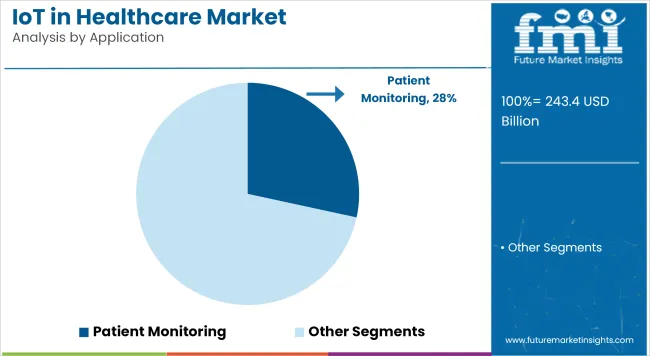
| Attributes | Details |
|---|---|
| Top Application | Patient Monitoring |
| Market Share in 2025 | 28.4% |
Patient monitoring is the leading application for IoT in healthcare industry and is poised to hold a market share of 28.4% in 2025.
IoT is used for a multitude of applications in the healthcare sector such as telemedicine, medication management, clinical operations, and patient monitoring. However, post-pandemic, the general populace has become a bit skeptical about visiting hospitals for normal check-ups.
This is because of the costs of frequent visits and consultation charges. In times like this, they are relying on telemedicine services where IoT devices come in handy. It is because of this reason, this sector is dominating the market.
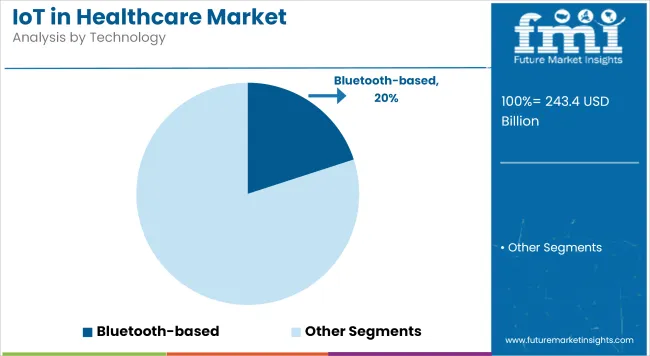
| Attributes | Details |
|---|---|
| Top Technology | Bluetooth-based |
Medical professionals prefer Bluetooth-based devices for monitoring vitals because they come with intuitive interfaces. This makes them easy for both, the patients as well as the doctors. Also, it enables real-time data and is not dependent upon cellular networks, which might be a challenge in some of the underdeveloped regions.
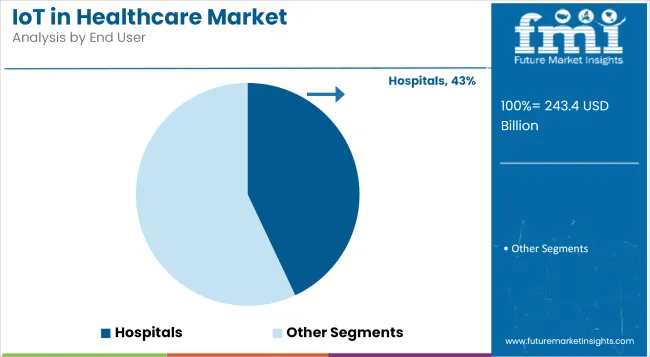
| Attributes | Details |
|---|---|
| Top End User | Hospitals |
Hospitals make the most of these devices as they enable continuous monitoring of patients' vital signs. Heart rates, blood pressure, and oxygen levels are easily monitored using these devices. And with real-time alerts for abnormal readings, medical staff can respond quickly to potential health crises, improving patient safety.
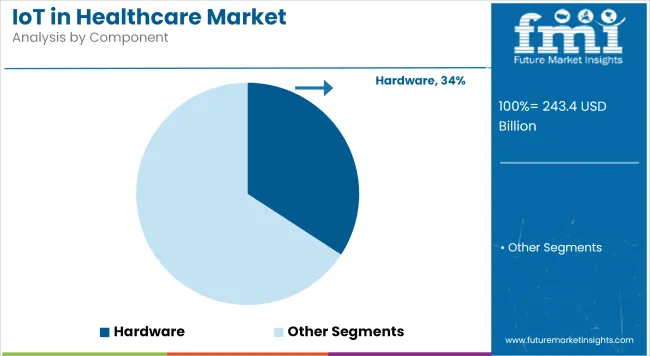
| Attributes | Details |
|---|---|
| Top Component | Hardware |
| Market Share in 2025 | 34.2% |
Hardware takes the largest share, of 34.2%, when it comes to components in this market.
While the healthcare sector is flooded with medical platforms and software, the market is dominated by IoT-integrated hardware. This is because of their ability to provide continuous, real-time monitoring of patients’ vital signs and health metrics, which is critical for timely interventions.
The following section talks about the region-wise analysis of the IoT in Healthcare market with a focus on prominent countries.
| Countries | Market Share(%) |
|---|---|
| India | 18.7% |
| Germany | 14% |
| The United States | 7% |
| Japan | 8.2% |
| South Korea | 16.4% |
The USA leads the global IoT healthcare market. This is because it benefits from advanced infrastructure and high technology adoption. Chronic diseases are increasingly prevalent, driving demand for IoT solutions. Besides this, telemedicine is well-established, supported by government initiatives like HITECH.
Focus areas in the country include remote monitoring, AI wearables, and smart hospitals. However, data privacy and regulatory compliance pose challenges.
Some of the prominent companies in the country include Medtronic, GE Healthcare, and Cisco.
The UK's NHS has actively adopted IoT technologies for patient care. It focuses on hospital management and efficient healthcare delivery. While remote healthcare solutions cater to the aging population, IoT helps manage chronic diseases like diabetes effectively.
Challenges in this market include budget constraints and patient data security concerns. The government invests in digital health strategies to boost the market. These efforts align with the NHS Long-Term Plan.
Japan is currently dealing with the problem of a growing aging population. One in every ten individuals in Japan is over sixty-five years old. In scenarios like this, IoT-integrated devices come in very handy. They make sure that all the vital data is sent to the medical professional on time. This way they can get timely intervention.
Besides this, the country is also a pioneer in robotics and integrating the latest technology in healthcare devices.
China is home to one of the largest populations on the planet. This population requires robust healthcare solutions to meet diverse needs. In such scenarios, IoT-integrated devices have become a necessity for healthcare facilities as they help manage large patient data swiftly. Besides this, government support in the form of subsidies and tax rebates has also helped healthcare facilities acquire these technologies easily.
Here's a table summarizing the competitive landscape in IoT-driven healthcare:
| Company | Activity |
|---|---|
| GE HealthCare | Acquired Zionexa (2021) |
| Philips | Expanded remote monitoring via acquisitions of BioTelemetry and Intact Vascular |
| Medtronic | Acquired Nutrino Health |
| Microsoft | Partnered with Novartis to leverage AI |
| Alphabet (Verily) | Collaborated with Novartis' Alcon unit on smart medical contact lenses |
| Apple | Developed sophisticated health-monitoring features for Apple Watch |
| Cisco | Advanced connected health solutions through secure networking |
| Qualcomm | Focused on connected health solutions |
| Otsuka Pharmaceutical | Continued Proteus Digital Health's technology post-bankruptcy (2020) |
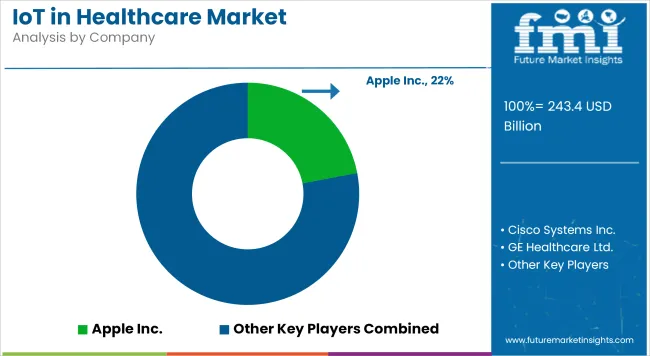
The global market is segmented, according to the IoT in healthcare sector analysis, into three main components: hardware, software, and services.
In terms of application, the market is divided into several key areas, including telemedicine, medication management, clinical operations, patient monitoring, connected imaging, and various healthcare applications.
The market is also categorized based on technology, which includes Bluetooth-based, Wi-Fi-based, NFC-based, Zigbee-based, RFID-based, and other emerging technologies.
Finally, the Global IoT in Healthcare market is segmented by end user, which comprises hospitals, pharmaceuticals, and clinics & laboratories.
The market can be segmented by region, encompassing North America, Europe, Asia Pacific, Middle East and Africa, and Latin America.
The market is set to surpass USD 1 trillion in revenue by 2035.
The market is is likely to reach USD 243 billion in 2025.
India is a lucrative market for IoT in Healthcare providers.






Our Research Products

The "Full Research Suite" delivers actionable market intel, deep dives on markets or technologies, so clients act faster, cut risk, and unlock growth.

The Leaderboard benchmarks and ranks top vendors, classifying them as Established Leaders, Leading Challengers, or Disruptors & Challengers.

Locates where complements amplify value and substitutes erode it, forecasting net impact by horizon

We deliver granular, decision-grade intel: market sizing, 5-year forecasts, pricing, adoption, usage, revenue, and operational KPIs—plus competitor tracking, regulation, and value chains—across 60 countries broadly.

Spot the shifts before they hit your P&L. We track inflection points, adoption curves, pricing moves, and ecosystem plays to show where demand is heading, why it is changing, and what to do next across high-growth markets and disruptive tech

Real-time reads of user behavior. We track shifting priorities, perceptions of today’s and next-gen services, and provider experience, then pace how fast tech moves from trial to adoption, blending buyer, consumer, and channel inputs with social signals (#WhySwitch, #UX).

Partner with our analyst team to build a custom report designed around your business priorities. From analysing market trends to assessing competitors or crafting bespoke datasets, we tailor insights to your needs.
Supplier Intelligence
Discovery & Profiling
Capacity & Footprint
Performance & Risk
Compliance & Governance
Commercial Readiness
Who Supplies Whom
Scorecards & Shortlists
Playbooks & Docs
Category Intelligence
Definition & Scope
Demand & Use Cases
Cost Drivers
Market Structure
Supply Chain Map
Trade & Policy
Operating Norms
Deliverables
Buyer Intelligence
Account Basics
Spend & Scope
Procurement Model
Vendor Requirements
Terms & Policies
Entry Strategy
Pain Points & Triggers
Outputs
Pricing Analysis
Benchmarks
Trends
Should-Cost
Indexation
Landed Cost
Commercial Terms
Deliverables
Brand Analysis
Positioning & Value Prop
Share & Presence
Customer Evidence
Go-to-Market
Digital & Reputation
Compliance & Trust
KPIs & Gaps
Outputs
Full Research Suite comprises of:
Market outlook & trends analysis
Interviews & case studies
Strategic recommendations
Vendor profiles & capabilities analysis
5-year forecasts
8 regions and 60+ country-level data splits
Market segment data splits
12 months of continuous data updates
DELIVERED AS:
PDF EXCEL ONLINE
Healthcare IoT Market
Healthcare Air Purifier Market Size and Share Forecast Outlook 2025 to 2035
IoT Network Management Market Size and Share Forecast Outlook 2025 to 2035
Healthcare Regulatory Affairs Outsourcing Market Size and Share Forecast Outlook 2025 to 2035
Healthcare and Laboratory Label Industry Analysis in the United States Size and Share Forecast Outlook 2025 to 2035
Healthcare Flooring Market Size and Share Forecast Outlook 2025 to 2035
Healthcare AI Computer Vision Market Size and Share Forecast Outlook 2025 to 2035
IoT Spend by Logistics Market Size and Share Forecast Outlook 2025 to 2035
Healthcare Business Intelligence Market Size and Share Forecast Outlook 2025 to 2035
Healthcare Master Data Management Market Size and Share Forecast Outlook 2025 to 2035
IoT Chip Market Size and Share Forecast Outlook 2025 to 2035
Healthcare and Laboratory Label Industry Analysis in Japan Size and Share Forecast Outlook 2025 to 2035
Healthcare and Laboratory Label Industry Analysis in Western Europe Size and Share Forecast Outlook 2025 to 2035
IoT Device Management Market Size and Share Forecast Outlook 2025 to 2035
IoT Application Enablement Market Size and Share Forecast Outlook 2025 to 2035
Healthcare Contact Center Solution Market Size and Share Forecast Outlook 2025 to 2035
IoT In Aviation Market Size and Share Forecast Outlook 2025 to 2035
IoT Processor Market Size and Share Forecast Outlook 2025 to 2035
Healthcare Semiconductor Market Size and Share Forecast Outlook 2025 to 2035
Healthcare Cold Chain Logistics Market Size and Share Forecast Outlook 2025 to 2035

Thank you!
You will receive an email from our Business Development Manager. Please be sure to check your SPAM/JUNK folder too.
Chat With
MaRIA